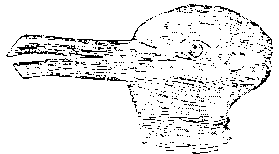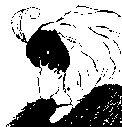Fantasia: The Nature of Perception
We love to build fantasies in our minds; creations of pleasure, hope,
judgement, regret, etc. We spend endless hours lost in these daydreams. Few
people give this habit any serious examination; most would feel that it is
harmless enough. If we consider it to any depth, however, some surprises can be
found in store.
The Buddha certainly seemed to feel that it was more
than a passing thought. He said:
It is in this fathom-long body, with its perceptions and its mind,
that I describe the world, the origin of the world.
(Sam. Nikaya II,
36; also Ang. Nikaya IV, 46)
The origin of the world.
How could that be? How could we think up the world? Oddly enough this is what
present day psychology states:
[From a] . . . superstructure of ideas or . . . gestalt of
relationships . . . are derived various concepts and functions, some of which
are . . . self, world, other people, time, space, logic, purpose, various
inhibitions, conscious fears, and defences.
239-40 Tart, Charles T.;
Altered States of Conciousness: A Book of Readings. John Wiley & Sons,
Inc. New York, 1969
What are they talking about? The
self and the world seem to be more than a thought. How could they be simply a
concept?
Many people have observed that the human mind loves patterns
or forms and enjoys creating them. In developing infants there is a preference
for staring at complex patterns rather than simple ones or listening to rhythms
instead of random noises. New technology can observe the attempts of the eye to
seek out shapes and forms within other shapes and forms that have already been
identified. This urge to find new patterns exists in all the senses.
 Figure1
Figure1
It is possible to see this tendency in our present
moment. Figure 1 is a neutral grid of dots. If we stare at it for some time the
natural movement of the mind will attempt to create patterns within it. There is
no obvious pattern here except for a number of dots equally spaced but the mind
does not read it in this way. It will attempt to view this as different forms;
vertical rows, horizontal rows, squares, diagonals and rectangles. If we keep
looking we can actually experience the frustrated attempts to create forms and
identify them but in this situation they cannot be sustained.
Another example of our pattern making concerns `how' we create an
object. We produce forms against a background. That is, we choose a pattern
against the background of another pattern (or patterns) to create a shape which
we can then identify (name). In the same way we find patterns of sound, physical
sensations, taste, smell, and `objects' in the mind. It's a particular sound
against the background of silence or other noise; a particular physical
sensation against the background of a general sense of the body; and so on. All
of these eventually become mental shapes in the background space of the mind.
![]() Figure2
Figure2
In figure 2 the background is
not so clear, therefore the shapes are unstable. One moment we see a black
goblet against a white background and the next moment we see two white faces
staring at each other against a black background. We cannot see these different
objects at the same time. Literally we create two worlds from this one basic
sensation.
 Figure3
Figure3
Even in a situation where the object does
stand out against a background the mind still has great joy in seeking various
forms with different meanings.
In figure 3 do you see a bird looking left? If
those are ears instead of a beak do you see a rabbit looking right?
 Figure3
Figure3
And in figure 4 do you see an old woman with a big
nose; her mouth pulled down close to her fur coat? Or do you see the cheek of a
young woman instead of a nose and, instead of a mouth, a choker on a long
beautiful neck?
In these situations we can actually experience the mind leaping about;
trying to create forms and give them various names. Obviously they aren't any of
these things, they are simply marks on paper. But what about that idea? When we
were born we would not have known these were marks on paper. We had to learn
that. We had to learn to identify forms that we would call paper and forms that
we call marks. Obviously that's what consciousness does. But what about that
pattern? When we were born we didn't know any ‘thing' called `consciousness'. We
had to learn to divide a pattern of some kind from all the other possible
patterns of sensation and name it `consciousness'.
Wherever we are our eyes go to certain visual patterns (objects) that
we like or dislike and we ignore all other visual sensations. Our ears hear
certain sound patterns that we like or dislike and ignore the others. We sit
lost in these mental patterns: patterns of physical sensation; of tastes; of
smells; of solid, stable patterns; patterns of movement, energy, space and
relationships between patterns. Even patterns of emptiness; ideas of no form, no
`thingness'. All of these become forms in the mind. We sit lost in our
`knowledge' thinking these limited experiences are some absolute reality.
As children our lives were mystery, wonder, and delight. There was
relative innocence and vulnerability. As we mature, the mind chooses a pattern
here, a form there; labelling, comparing, judging, always remembering; building
its fortress of forms, names, images, concepts, views and opinions. We rarely
see what is. Instead we are locked in this fortress, an interpretation,
one particular arrangement of patterns, one particular view, one well-worn
habit.
With this in mind it is worth considering the Buddha's teaching:
It is in this fathom-long body, with its perceptions and its mind,
that I describe the world, the origin of the world.
Sam. Nikaya II
36; Ang. Nikaya IV 48
Name and form is the necessary condition for the sixfold body base . .
.
Consciousness is the necessary condition for name and form . . .
but
name and form is the necessary condition for consciousness . . .
This
consciousness turns back upon itself; it does not extend beyond name and form.
Sam. Nikaya, 65
No matter what concept of self arises, the fact is always other than the
concept.
Udana III 10
. . . types of self arise as though they were true . . . but this field of
views is the thicket of views, the wilderness of views, the contortion of
views, the vacillation of views.
Maj. Nikaya 2
Perceptions such as `I am', `I am not', `I will be', `I will not be', `I
will have form', `I will not have form', `I will have perceptions', `I will
not have perceptions', `I will neither have nor not have perceptions'; monks,
are an affliction, an ulcer, a dart. By transcending these perceptions one is
a muni, a peaceful one.
Monks, the muni is not born, does not age, does not
die, is not confused, he does not yearn.
Maj. Nikaya III, 246
. . . feelings, thoughts, perceptions still arise in an awakened one but he
knows them for what they are.
Maj. Nikaya 123
Some people view life as `consciousness' in a `body' in an external
`world'. Scientists have viewed it as atoms and molecules, lines of force,
pure energy. Some religions view it as mind itself. Can we come to understand
these views, this machine of thought? In meditation we can experience these
perceptions as passing sensations, not absolute realities, and in that
awareness is the experience of essential freedom; not formed, not bound, not
controlled. Stepping out of perception to know perception for what it is. In
meditation we experience the release from our worlds. The Buddha's word for
this was mindfulness. In this ‘fullness' mind, which is not fragmented or
conflicted, the perceptions and thoughts are part of that fullness but they do
not blindly take control.
The Buddha asked us to understand views, to see their limitations
and to experience the freedom of not attaching to them. We can use them wisely
for the necessities of living and we can let them go. In his thoroughness he
cautioned us against attaching to even his own teaching which he described as
a raft for crossing a river of pain. He warned us against picking up the raft
and carrying it around on our heads.
So, back to the grid of dots. If I ask you "Is this a group of
vertical rows?" you would say "Yes", because it can be perceived in that way.
If I asked "Is this a group of horizontal rows?" you would say "Yes", because
it can be perceived that way. "Is it triangles or diagonal rows?" - "Yes".
What is it really? It depends on how you look at it.
Venerable Sunnato
 Return to
Index of FSN Issue 32
Return to
Index of FSN Issue 32
 Figure1
Figure1 Figure3
Figure3 Figure3
Figure3